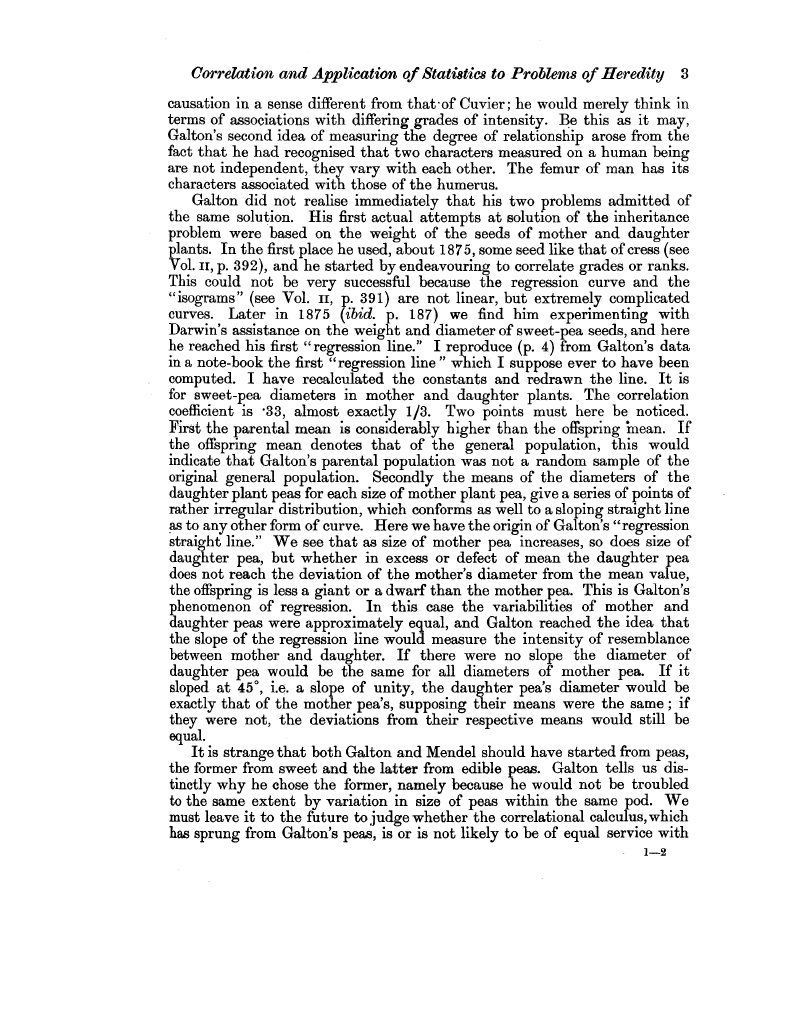| ||||||

OCR Rendition - approximate
Correlation and Application of Statistics to Problems of Heredity 3 causation in a sense different from that-of Cuvier; he would merely think in terms of associations with differing grades of intensity. Be this as it may, Galton's second idea of measuring the degree of relationship arose from the fact that he had recognised that two characters measured on a human being are not independent, they vary with each other. The femur of man has its characters associated with those of the humerus. Galton did not realise immediately that his two problems admitted of the same solution. His first actual attempts at solution of the inheritance problem were based on the weight of the seeds of mother and daughter plants. In the first place he used, about 1875, some seed like that of cress (see Vol. 11, p. 392), and he started by endeavouring to correlate grades or ranks. This could not be very successful because the regression curve and the "isograms" (see Vol. ii, p. 391) are not linear, but extremely complicated curves. Later in 1875 (ibid. p. 187) we find him experimenting with Darwin's assistance on the weight and diameter of sweet-pea seeds, and here he reached his first "regression line." I reproduce (p. 4) from Galton's data in a note-book the first "regression line " which I suppose ever to have been computed. I have recalculated the constants and redrawn the line. It is for sweet-pea diameters in mother and daughter plants. The correlation coefficient is •33, almost exactly 1/3. Two points must here be noticed. First the parental mean is considerably higher than the offspring mean. If the offspring mean denotes that of the general population, this would indicate that Galton's parental population was not a random sample of the original general population. Secondly the means of the diameters of the daughter plant peas for each size of mother plant pea, give a series of points of rather irregular distribution, which conforms as well to a sloping straight line as to any other form of curve. Here we have the origin of Galton's "regression straight line." We see that as size of mother pea increases, so does size of daughter pea, but whether in excess or defect of mean the daughter pea does not reach the deviation of the mother's diameter from the mean value, the offspring is less a giant or a dwarf than the mother pea. This is Galton's phenomenon of regression. In this case the variabilities of mother and daughter peas were approximately equal, and Galton reached the idea that the slope of the regression line would measure the intensity of resemblance between mother and daughter. If there were no slope the diameter of daughter pea would be the same for all diameters of mother pea. If it sloped at 45°, i.e. a slope of unity, the daughter pea's diameter would be exactly that of the mother pea's, supposing their means were the same ; if they were not, the deviations from their respective means would still be equal. It is strange that both Galton and Mendel should have started from peas, the former from sweet and the latter from edible peas. Galton tells us distinctly why he chose the former, namely because he would not be troubled to the same extent by variation in size of peas within the same pod. We must leave it to the future to judge whether the correlational calculus, which has sprung from Galton's peas, is or is not likely to be of equal service with - 1-2
|